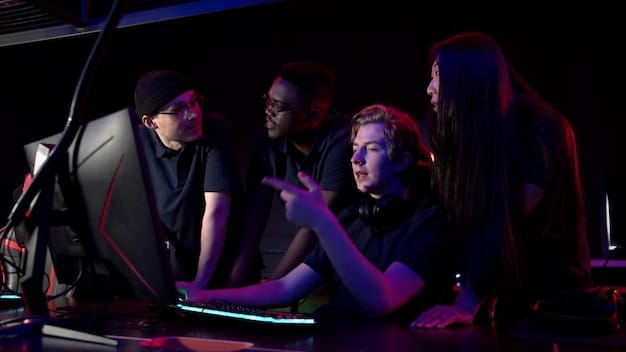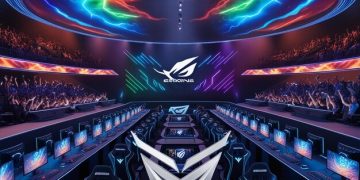Qualify for 2025 Esports World Championship: US Team Guide

Qualifying for the 2025 Esports World Championship as a US team demands a strategic approach, encompassing consistent high-level tournament performance, robust team development, and adherence to specific game publisher and federation guidelines.
The dream of competing on the global stage, representing the United States in the 2025 Esports World Championship, fuels countless aspiring professional gamers. For US teams, navigating the path to qualification is a complex journey, requiring not only exceptional skill and teamwork but also a keen understanding of the intricate ecosystems spanning various game titles and organizational structures. This comprehensive guide aims to demystify the process, offering a detailed, step-by-step guide for US teams on how to qualify for the 2025 Esports World Championship.
Understanding the Esports Landscape for 2025 Qualifications
Understanding the current esports landscape is the foundational first step for any US team aspiring to reach the 2025 Esports World Championship. This involves not just knowing the popular titles, but also delving into the specific competitive structures, regional qualifiers, and the underlying organizations that govern these events. The esports world is a dynamic ecosystem, constantly evolving with new games, formats, and qualification pathways, making continuous research paramount.
The fragmentation of the esports scene means that qualification routes differ significantly from one game to another. While some titles might operate under a centralized league system, others rely on a series of independent tournaments, with accumulated points dictating World Championship berths. Recognizing these nuances early on can save significant time and resources, allowing teams to focus their efforts on the most relevant competitions and strategies. Furthermore, the role of national esports federations is increasingly prominent, often serving as a crucial link between local talent and international events. Their guidelines and recommendations can heavily influence a team’s journey.
The Role of Game Publishers and Esports Federations
Game publishers are the primary architects of their respective competitive scenes. They dictate game rules, patch cycles, and often the overarching structure of their professional leagues and international tournaments. For instance, Riot Games handles League of Legends and Valorant, while Valve manages Dota 2 and CS2. Each publisher has its own set of rules and qualification pathways that teams must meticulously follow to even be considered.
Esports federations, such as the International Esports Federation (IESF) or the Global Esports Federation (GEF), often collaborate with publishers to establish standardized rules and facilitate multi-game events like the Esports World Championship. These federations play a vital role in unifying diverse competitive scenes under a broader umbrella, promoting fair play, and providing a gateway for national representation. For US teams, aligning with national federations can offer valuable insights and support throughout the qualification process, potentially opening doors to opportunities not available through publisher-specific circuits alone.
Key Games and Their Qualification Structures
The Esports World Championship typically features a selection of popular titles, which can vary year by year. However, staple games often include those with established global fanbases and competitive infrastructures. Understanding each game’s specific qualification journey is paramount.
- League of Legends: Usually follows a regional league format (e.g., LCS for North America), with top teams advancing to international tournaments like MSI and Worlds based on their seasonal performance.
- Valorant: Riot’s tactical shooter operates with an “ecosystem” of regional leagues and international events (e.g., VCT Americas League), culminating in Champions as the ultimate global event.
- Dota 2: The DPC (Dota Pro Circuit) points system typically determines qualification for The International, its premier event.
- CS2 (Counter-Strike 2): Qualification often involves a series of independent tournaments (Majors) and regional qualifiers organized by third-party organizers like ESL and BLAST.
Each of these games presents a unique challenge and a distinct path to the World Championship. Teams must evaluate their strengths, the game’s competitive meta, and the existing talent pool to choose the title where they have the strongest chance of success. This initial strategic decision will shape every subsequent step in their qualification journey. Success hinges not just on raw skill, but on a deep understanding of these intricate systems.
Building a Championship-Calibre US Esports Team
Building a team capable of reaching the Esports World Championship is a rigorous process that goes far beyond simply finding talented players. It requires a strategic approach to recruitment, fostering a cohesive and resilient team culture, and providing the necessary infrastructure for growth and sustained performance. For US teams, this means not only competing against domestic rivals but also preparing to face the world’s best.
The foundation of any successful esports team is its players. Recruitment should be a meticulous process, focusing on individual skill, game knowledge, and a strong competitive drive. However, individual talent alone is insufficient. Players must also exhibit characteristics that contribute positively to a team environment, such adaptability, good communication skills, and emotional resilience under pressure. A balanced roster typically includes players who excel in different roles and can complement each other’s playstyles effectively.
Recruiting and Developing Top Talent
Identifying and recruiting top talent is a continuous endeavor. Coaches and managers should scour high-ranked ladders, collegiate esports programs, and smaller regional tournaments for promising individuals. Beyond raw mechanical skill, evaluate players on their game sense, strategic thinking, and ability to learn and adapt.
Player development is equally crucial. This involves not just practice, but also structured coaching, VOD (video on demand) review, and psychological support. A good coach can help players identify weaknesses, refine strategies, and improve their in-game communication. Regular scrims against strong opponents are essential for testing new tactics and building synergy. Moreover, fostering an environment where players feel comfortable giving and receiving constructive criticism is vital for continuous improvement and maintaining a competitive edge.
Establishing Team Synergy and Communication
Esports is inherently a team sport, and synergy is the invisible force that binds a championship-winning roster. This involves intuitive understanding between players, predictive movements, and seamless coordination during high-pressure situations. Effective communication is the bedrock of this synergy.
- Clear Callouts: Players must be able to communicate critical information quickly and unambiguously.
- Role Clarity: Each player should understand their primary and secondary roles within the team’s strategy.
- Trust and Respect: A strong team bond, built on trust and mutual respect, allows for honest feedback and better collaboration.
- Adaptability: Teams must be able to adapt their strategies mid-game based on opponent actions and in-game developments.
Team-building exercises outside of the game, even simple shared activities, can significantly improve interpersonal relationships and translate into better in-game performance. A cohesive team that communicates effectively is often more formidable than a collection of individually skilled players who lack synergy. Maintaining such a team requires consistent effort and leadership both within and outside the digital arena, ensuring everyone is aligned towards the common goal of qualifying for the World Championship.

Navigating Regional Qualifiers and Tournament Schedules
The journey to the 2025 Esports World Championship for US teams is heavily dependent on navigating the complex web of regional qualifiers and maintaining a rigorous tournament schedule. Unlike traditional sports, where a clear league structure often dictates progression, esports often features a dynamic calendar of events, each with its own set of rules and significance. Success in this phase requires meticulous planning, strategic tournament selection, and consistent performance under pressure.
Regional qualifiers serve as the primary gateways to international competition. For US teams, this typically means competing within North American circuits, which can vary significantly by game. Some games might have direct invitations to the World Championship for top-performing regional teams, while others might feed into a larger intercontinental qualifier. Understanding these specific pipelines is crucial for selecting the right tournaments to prioritize and allocate resources efficiently. Overextending by participating in too many irrelevant events can lead to player burnout and diluting focus.
Identifying Key Regional Tournaments and Leagues
For US teams, the path to the World Championship almost always funnels through regional competitions. These can be publisher-organized leagues (e.g., the LCS for League of Legends, VCT Americas for Valorant) or major third-party tournaments that offer qualification points or direct slots.
Thorough research is non-negotiable. Teams must identify the most impactful events within their chosen game’s ecosystem that offer qualification opportunities for the 2025 World Championship. This includes understanding the prize pools, the prestige of the event, and critically, how top placements translate into qualification points or direct berths. Many events might award “circuit points” that aggregate over a season, with the highest-scoring teams earning their spot, while others might be single-elimination qualifiers where only the winner advances. Mapping out this competitive landscape provides a clear roadmap for the season.
Managing Tournament Schedules and Player Wellness
A packed tournament schedule can be mentally and physically grueling for esports players. Managing this intense calendar effectively is key to avoiding burnout and maintaining peak performance throughout the season. This requires a delicate balance between competition and recovery.
- Strategic Selection: Don’t play in every tournament; prioritize those with the clearest path to qualification.
- Rest and Recovery: Implement scheduled breaks for players to recuperate physically and mentally.
- Mental Health Support: Provide resources for psychological well-being, acknowledging the high-stress environment of professional esports.
- Performance Coaching: Utilize sports psychologists or performance coaches to help players manage pressure and maintain focus.
Travel logistics, time zone changes, and differing tournament environments can all impact player performance. Teams must plan meticulously for these aspects, ensuring players have adequate preparation time, comfortable accommodations, and consistent access to nutritional meals. A well-managed schedule not only optimizes performance but also contributes to the longevity and overall health of the team, which is vital for a grueling qualification season.
Strategic Practice and Performance Optimization
Strategic practice and performance optimization are the ongoing engines that drive a team towards the Esports World Championship. Merely playing the game extensively is not enough; practice must be deliberate, structured, and aimed at continually improving every aspect of individual and team play. For US teams, this means not only catching up to international standards but constantly striving to set new benchmarks in competitive excellence.
Performance optimization extends beyond just in-game mechanics. It encompasses understanding the meta-game, developing counter-strategies, and meticulously analyzing both their own gameplay and that of their competitors. The esports landscape is constantly evolving, with game updates, balance changes, and new strategies emerging regularly. A championship-calibre team must be agile, capable of quickly adapting and integrating new information into their playstyle.
Effective Practice Routines and Scrim Management
Effective practice routines are the backbone of any successful esports team. These routines should be structured, goal-oriented, and meticulously designed to target specific areas of improvement. Simply queuing up for ranked games or playing casually will not yield the results needed for World Championship qualification.
Scrims (scrimmages against other professional or semi-professional teams) are the most crucial component of practice. However, scrims need structure. Teams should enter scrims with specific objectives, whether it’s testing a new strategy, refining communication, or practicing specific in-game scenarios. Post-scrim review sessions are equally important, where coaches and players analyze mistakes, identify patterns, and adapt their approach. Data analytics tools can also provide invaluable insights into player performance and team dynamics, highlighting areas for improvement.
Advanced Game Analysis and Meta-Adaptation
The esports meta-game is the prevailing set of strategies, characters, items, or tactics considered most effective at any given time. Understanding and adapting to the meta, or even creating a new one, is a hallmark of elite teams. This requires deep game knowledge and analytical skills.
- Patch Analysis: Thoroughly analyze every game patch for changes that could shift the meta.
- Opponent Scouting: Study top international teams and regional rivals to understand their strategies, preferred compositions, and weaknesses.
- Innovative Strategies: Don’t just follow the meta; experiment and innovate to gain a competitive edge.
- Data-Driven Decisions: Use in-game statistics and analytics to inform strategic choices and draft compositions.
Teams that can quickly adapt to meta shifts or even dictate the meta often find themselves at the top. This proactive approach to game analysis, combined with a willingness to experiment and refine strategies, is critical for competitive success. For US teams looking to make a deep run at the 2025 Esports World Championship, staying ahead of the curve through advanced game analysis and meta-adaptation is not just an advantage—it’s a necessity.
Financial Planning and Sponsorships for US Teams
Financial planning and securing sponsorships are often overlooked aspects for aspiring US esports teams, yet they are absolutely critical for sustained success and the ability to compete at the highest levels. The reality is that professional esports requires significant investment—from player salaries and coaching staff to travel, equipment, and training facilities. Without a solid financial foundation, even the most talented team can struggle to maintain competitive edge and ultimately reach the World Championship.
For a US team, funding typically comes from a combination of prize money, merchandise sales, streaming revenue, and most importantly, sponsorships. Early-stage teams might rely more on grassroots funding or support from smaller organizations. However, to truly commit to a championship run and support players full-time, robust sponsorship deals become essential. This involves not only attracting potential sponsors but also understanding how to present a compelling value proposition that showcases the team’s potential reach and engagement.
Securing Sponsorships and Brand Partnerships
Sponsorships are the lifeblood of professional esports organizations. For US teams, attracting sponsors means demonstrating value beyond just in-game performance; it also encompasses brand alignment, audience engagement, and overall marketability.
Teams should develop professional media kits that highlight their achievements, player personalities, social media presence, and audience demographics. Approach potential sponsors whose target market aligns with the esports audience. Beyond financial backing, partnerships can provide essential resources like gaming peripherals, apparel, and marketing support, which is invaluable for a developing team. Look for long-term relationships where both parties benefit, fostering a sustainable ecosystem around the team.
Budget Management and Investment in Infrastructure
Effective budget management is crucial to ensure financial stability and optimize resource allocation. This includes careful planning for operational costs, salaries, travel expenses, and investment in necessary infrastructure.
- Player Salaries: Competitive salaries and benefits are essential to attract and retain top talent.
- Coaching Staff: Investing in experienced coaches, analysts, and support staff (e.g., sports psychologists, physical trainers).
- Gaming Equipment: High-performance PCs, monitors, peripherals, and reliable internet connectivity.
- Training Facility: A dedicated space for practice, team meetings, and content creation (optional but highly beneficial).
- Travel and Accommodation: Budget for flights, hotels, and ground transportation for tournaments.
Beyond the immediate needs, teams should also consider long-term investments, such as brand building, content creation, and even academic support for younger players. A well-managed budget allows a team to focus on performance without constant financial anxieties, creating a stable environment conducive to qualifying for the 2025 Esports World Championship.

Maintaining Mental and Physical Health in Esports
The demanding world of professional esports often overlooks the critical importance of maintaining mental and physical health. For US teams aspiring to the 2025 Esports World Championship, ignoring these aspects can lead to burnout, decreased performance, and ultimately, the premature end of a promising career. The intense hours of practice, coupled with the high-stakes environment of competitive play, place immense stress on players, making a holistic approach to well-being absolutely essential.
Long hours in front of a screen can lead to various physical ailments, including repetitive strain injuries, eye strain, and poor posture. Mentally, the pressure to perform, combined with public scrutiny and the constant threat of roster changes, can lead to anxiety, depression, and significant emotional strain. Teams that recognize and address these challenges proactively are better positioned for sustained success, ensuring their players remain sharp, resilient, and ready to compete at their highest level.
Physical Well-being and Injury Prevention
Physical health is foundational to sustained peak performance in esports. While not as outwardly physical as traditional sports, the constant repetitive motions and prolonged sitting pose unique health risks.
Teams should prioritize ergonomics, investing in high-quality chairs, desks, and peripherals that support good posture and reduce strain. Regular breaks during practice sessions are crucial for stretching and moving around. Additionally, incorporating physical exercise into daily routines can counteract the sedentary nature of esports. This includes cardio for cardiovascular health and strength training to support endurance and prevent injuries like carpal tunnel syndrome or tendinitis. Proper nutrition and hydration also play a vital role in maintaining energy levels and cognitive function.
Mental Resilience and Stress Management
The mental game in esports is arguably as important as the mechanical skill. Players face immense pressure to perform, deal with losses, and manage public and team expectations. Developing mental resilience is paramount for long-term success.
- Sports Psychology: Access to a sports psychologist can help players develop coping mechanisms for stress and anxiety.
- Team Communication: Foster an open environment where players feel comfortable discussing mental health concerns.
- Work-Life Balance: Encourage players to maintain hobbies and interests outside of the game to prevent burnout.
- Mindfulness Practices: Techniques like meditation can improve focus, reduce stress, and enhance emotional regulation.
Support for mental health should be integrated into the team’s culture, making it clear that seeking help is a sign of strength, not weakness. A mentally resilient team can better weather the storms of competitive play, learn from mistakes, and maintain their drive even after setbacks. This holistic approach ensures that players are not only at their best in-game but also healthy and balanced individuals, crucial for facing the challenges of qualifying for and competing in the 2025 Esports World Championship.
Compliance and Fair Play: Adhering to Global Standards
Compliance and fair play form the ethical backbone of competitive esports. For US teams embarking on the journey to the 2025 Esports World Championship, adhering to global standards is not merely a formality but a fundamental requirement for legitimacy, integrity, and preventing disqualification. The competitive landscape is governed by a complex set of rules enforced by game publishers, tournament organizers, and overarching esports federations, all designed to ensure a level playing field and uphold the spirit of competition.
Ignoring these rules, whether intentionally or through negligence, can lead to severe penalties, ranging from fines and match forfeitures to lifetime bans from competition. This makes it imperative for every team member, from players to coaching staff and management, to be thoroughly educated on the relevant rulebooks. Beyond explicit rules, upholding the principles of fair play involves demonstrating good sportsmanship, avoiding disruptive behavior, and respecting opponents, referees, and the competitive process itself.
Understanding Tournament Rules and Regulations
Every major esports tournament and league operates under a detailed set of rules and regulations. These documents cover everything from eligible players and roster lock dates to in-game conduct, equipment restrictions, and prize distribution.
Teams must dedicate time to thoroughly read and understand the rulebooks for every competition they participate in, especially those directly leading to the World Championship. This includes rules on prohibited software, anti-doping policies (which are becoming increasingly prevalent in esports), and communication guidelines. Misunderstanding a rule can lead to unintentional violations and severe consequences that jeopardize a team’s qualification chances. Appointing a dedicated team manager or compliance officer to stay abreast of all regulations can be a wise investment.
Promoting Sportsmanship and Ethical Conduct
Fair play and ethical conduct are not just about following rules; they are about embodying the values of sportsmanship. This creates a positive competitive environment and enhances the reputation of both the team and the esports industry.
- Anti-Cheating Policies: Implement strict internal policies against any form of cheating or exploitation.
- Positive Online Conduct: Encourage players to maintain respectful behavior on social media and in-game chat.
- Respectful Competition: Instill values of respect for opponents, tournament organizers, and fans.
- Integrity: Uphold the integrity of the game and competition at all times, avoiding match-fixing or illicit betting behaviors.
A team that builds a reputation for sportsmanship and ethical conduct not only gains respect within the community but also becomes more attractive to sponsors and fans. This strong ethical foundation contributes to a team’s overall success and provides a moral compass through the pressures of highly competitive play. For US teams aiming for the 2025 Esports World Championship, integrity is as crucial as skill.
Future-Proofing Your Team: Adaptability and Growth
Future-proofing an esports team is about more than just staying relevant; it’s about anticipating change, embracing innovation, and fostering a culture of continuous adaptability and growth. The esports industry is notoriously fast-paced, with game metas shifting, new titles emerging, and competitive formats evolving almost constantly. For US teams striving for the 2025 Esports World Championship, a static approach is a guaranteed path to obsolescence. Instead, a proactive mindset centered on agility and strategic evolution is essential to thrive amidst this dynamism.
Adaptability applies not only to in-game strategies but also to organizational structures, player development philosophies, and even fan engagement tactics. Teams that can quickly pivot, learn from failures, and embrace new technologies or trends are the ones that will maintain their competitive edge and continue to attract top talent and loyal fanbases. This forward-thinking approach ensures that even after the 2025 World Championship, the team remains a formidable contender in the ever-changing esports landscape.
Embracing Innovation and New Technologies
The esports world is driven by technological advancements. From in-game mechanics to training tools and broadcast technologies, innovation constantly reshapes how games are played and consumed.
Teams should actively seek to integrate new technologies into their training. This could include advanced analytics platforms, AI-driven coaching tools, or even VR training simulations for improving specific skills. Streaming platforms and content creation tools are also vital for building a brand and engaging with fans, which indirectly supports financial health through sponsorships. Staying updated with cutting-edge hardware and software can provide a tangible competitive advantage, ensuring players are always equipped with the best possible tools for performance.
Long-Term Vision and Sustainable Growth
A championship run isn’t just about one year; it’s about building a legacy. Teams need a long-term vision that extends beyond the 2025 World Championship, focusing on sustainable growth and continuity.
- Talent Pipeline: Invest in scouting and developing new talent, potentially through an academy system.
- Brand Building: Cultivate a strong team identity and brand image that resonates with fans.
- Community Engagement: Actively engage with fans through social media, streaming, and community events.
- Diversification: Explore opportunities in multiple game titles or new esports ventures to broaden reach and revenue streams.
Sustainable growth means prioritizing the well-being and development of players and staff, fostering a positive organizational culture, and making strategic decisions that ensure the team’s relevance for years to come. By focusing on adaptability and cultivating a long-term vision, US teams can not only aim for the 2025 Esports World Championship but also establish themselves as enduring forces in the global esports arena.
| Key Qualification Aspect | Brief Description |
|---|---|
| 🎮 Game Understanding | Master specific game mechanics, meta, and publisher rules. |
| 🤝 Team Synergy | Develop strong communication and cohesive play among teammates. |
| 🗓️ Tournament Strategy | Select key regional qualifiers and manage competitive schedule effectively. |
| 💰 Financial Stability | Secure sponsorships and manage budget for sustained team operations. |
Frequently Asked Questions About Esports World Championship Qualification
Primary pathways typically involve success in regional leagues (e.g., LCS, VCT Americas) or earning circuit points through a series of major tournaments sanctioned by game publishers. National esports federations may also offer additional routes for national representation in some titles.
Team synergy and communication are critically important; they often make the difference between good teams and championship teams. Seamless coordination, clear callouts, and mutual trust amplify individual skill and are essential for strategic execution under pressure during crucial matches.
Game publishers are central to the qualification process as they own the intellectual property and often dictate the entire competitive structure, including rules, regional leagues, and direct qualification slots for their respective World Championship events. Teams must adhere strictly to their regulations.
Qualifying for the World Championship demands significant financial resources for salaries, travel, and infrastructure. US teams typically secure funding through prize money, streaming revenue, and crucial sponsorships. Professional financial planning and seeking aligned brand partnerships are vital for sustainability.
Maintaining player well-being is crucial and involves prioritizing physical health through ergonomics, exercise, and nutrition, alongside robust mental health support. This includes access to sports psychologists, scheduled breaks, and fostering an environment that encourages open communication and a healthy work-life balance.
Conclusion
The journey for US teams aspiring to qualify for the 2025 Esports World Championship is undeniably arduous, demanding a multifaceted approach that extends beyond raw talent. It requires a profound understanding of the intricate esports ecosystem, strategic team building, meticulous planning for regional qualifiers, and an unwavering commitment to continuous improvement. Success hinges on a harmonious blend of exceptional in-game skill, robust team synergy, physical and mental resilience, and sound financial management. By diligently following these steps and embracing a culture of adaptability and growth, US teams can significantly enhance their prospects of proudly representing their nation on the global stage, proving that the American esports dream is well within reach through dedication and strategic execution.





